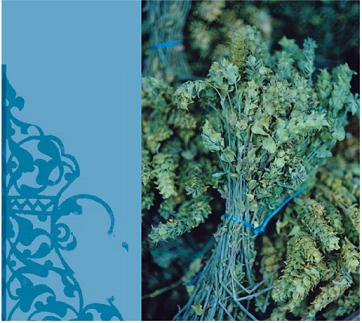

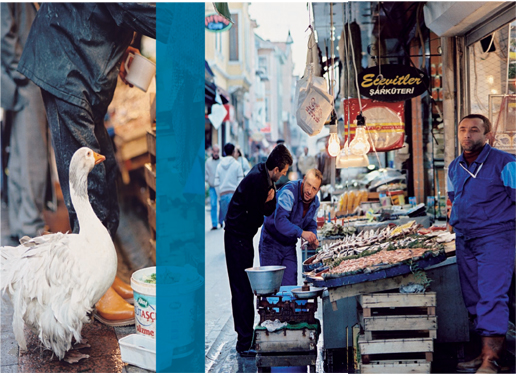
Dusk was falling and the market was full of shoppers stocking up for dinner.
Before there was Byzantium there was Chalcedon, a small colony perched on the southernmost shore of the Bosphorus at the threshold of Asia. It had been happily settled since ancient times, until Greek colonists arrived on the scene in the seventh century BC, establishing a bigger and better city on the opposite – superior – shore. They named this city Byzantium. These two colonies worked in partnership for the next few centuries to control trade through the Bosphorus, but the reality was that Chalcedon just wasn’t as well positioned geographically. And so, as Byzantium grew to greatness, Chalcedon sank into obscurity.
Ancient Chalcedon is modern Kadiköy, in the Asian part of Istanbul. Even today it has less obvious charms than the European suburbs, being primarily a residential area with little evidence remaining of its ancient past. But we’d been advised to miss a visit to Kadiköy at our peril. For here, we were assured, was some of the best food to be had in the whole of Turkey.
So late one March afternoon, we met up with our friend Sedat at the Eminönü ferry terminal. The waterfront was thronged with commuters going about the business of daily life. In the jostling queue for the Kakidöy ferry, men in suits and thick knitted skullcaps rubbed up against students with dreadlocks and little old ladies in raincoats. Even though the sun was shining, everyone was rugged up in scarves, gloves and boots against the chill.
Swept on board the lumbering old ferry by the crowd, we clambered up the wide staircase to the top passenger deck. The ferry chugged off on its journey across the Bosphorus, and we had just enough time to enjoy a glass of hot çay from the wandering tea seller before we spied the grand old Haydarpa a railway station looming up ahead. Then suddenly we had arrived. The ferry was docking and we stepped out onto Asian soil.
a railway station looming up ahead. Then suddenly we had arrived. The ferry was docking and we stepped out onto Asian soil.
After negotiating the roaring traffic behind the ferry terminus we ducked down a narrow laneway, emerging into a crowded street market. Dusk was falling and the market was full of shoppers stocking up for dinner. From all sides, we were offered tastes of honey or halva; roasted chickpeas; slivers of tasty white Turkish cheese; green, pink, brown and black-hued olives; and the famous Istanbul mussels stuffed with dill-flavoured rice.
It was hard not to be tempted, but we were set firmly on course for Çiya where we’d been invited to dinner with legendary Turkish chef, Musa Da deviren. It turned out that Çiya is actually a cluster of three small restaurants: a sofrasi, which specialises in soups, salads and stews; a kebab köfteci, or bread and meat restaurant; and a third that seems to do a mix of everything. The Çiya restaurants have earned wide and lavish praise for their menus of authentic regional dishes, sourced from villages all around Turkey – the sort of food, we’d been told, that you just don’t find on other menus around town.
deviren. It turned out that Çiya is actually a cluster of three small restaurants: a sofrasi, which specialises in soups, salads and stews; a kebab köfteci, or bread and meat restaurant; and a third that seems to do a mix of everything. The Çiya restaurants have earned wide and lavish praise for their menus of authentic regional dishes, sourced from villages all around Turkey – the sort of food, we’d been told, that you just don’t find on other menus around town.
We were warmly welcomed by Musa and his wife Zeynep, who offered glasses of a refreshingly sour–sweet sumac sherbet as we took our seats. Zeynep, who manages the three busy restaurants, was small and bursting with energy. Musa was tall and lean with a healthy-looking moustache and a charming, gentle manner. But there was also an intensity gleaming in his coal-black eyes, and it soon became apparent that here was a man with a mission.
Over our sherbet, and with Sedat translating, Musa began to tell us about his life, his restaurants and his passion for what he calls ‘the forgotten peasant dishes of Anatolia’. He’s not interested in the stuff churned out by traditional Turkish restaurants, but in the cooking that people do in their own homes in villages around the country.
‘The thing that really holds my imagination is the food that poor people make from almost nothing,’ he said. ‘Anyone can cook fancy meals with expensive ingredients. I think it’s far more beautiful to see someone cook a delicious meal from weeds and tree roots, or use lentils if there’s no meat or to make a soup just from yoghurt and cracked wheat.’
While Musa talked, dishes were arriving on the table thick and fast. We crunched on tiny pickled peppers and sipped a delicate yoghurt soup brimming with young green garlic shoots. There was a salad of wild thyme, followed by braised artichokes stuffed with rice, mint, pine nuts and currants, and tiny pea-sized köfte dumplings in an intensely flavoured tomato sauce.
In his gently insistent way Musa continued, ‘For the last twenty years or so I’ve been travelling everywhere around the rural parts of Turkey, going into people’s homes and cooking with them, learning about the ingredients they use, watching what they do, and also trying to understand the ritual and method that goes with the food they cook.’
He laughed, ‘When I find a new dish that excites me, I go a bit mad! What I’ve done, really, is to make the restaurants into my own personal test kitchen where I try to recreate the recipes I find from my research and travels.’
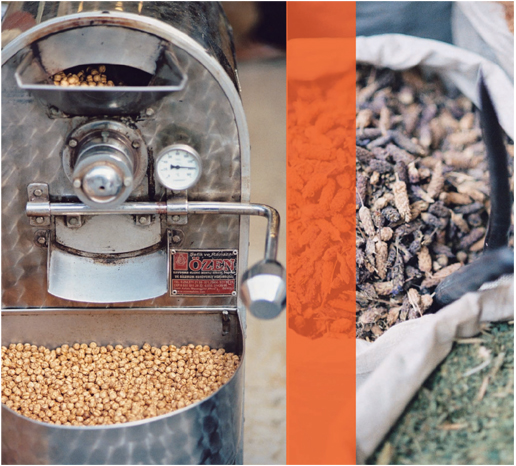
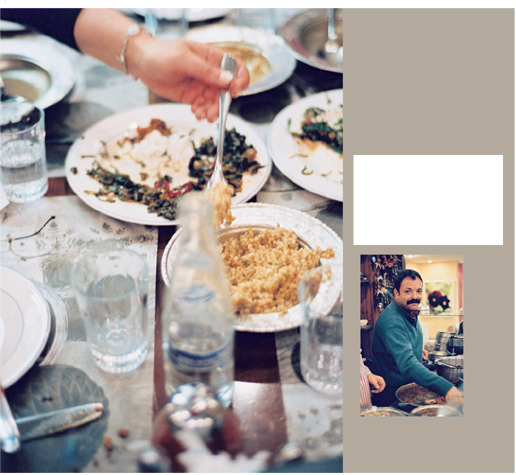
It was impossible to stop eating. More dishes had arrived tender lamb kebabs grilled with Turkish truffles, which we stuffed into hot, chewy, ‘house made’ bread.
He rolled up pieces of crisp, wafer-thin lahmacun smeared with a spicy meat paste and offered them around, before continuing. ‘But I’m a realist, too. I know that a lot of traditional peasant recipes use ingredients that are very localised. There are literally hundreds of wild greens that grow around the Aegean coastline, for instance, that people in the rest of Turkey know nothing about. And there’s no point making winter dishes from Antep, using the solid fat from the sheep’s tail in the traditional way that they do, and offering it to urbanite Istanbullus. It would give them a heart attack – literally!’
Musa’s genius seems to be knowing how to preserve the essence of a dish and adapting it to new surroundings, without slavishly recreating dishes in a way that would otherwise be esoteric at best, and utterly impractical at worst.
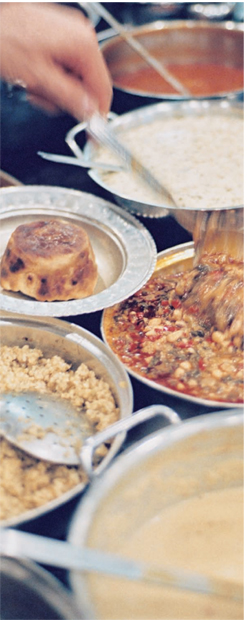
It was impossible to stop eating. More dishes had arrived – tender lamb kebabs grilled with Turkish truffles, which we stuffed into hot, chewy, ‘house made’ bread. There was a pilav from eastern Anatolia, thick with shreds of chicken and tiny currants, next came grilled intestines stuffed with savoury cracked wheat and finally a casserole of tiny chunks of lamb, grapes and chickpeas from central Anatolia.
We learned that Musa serves more than a thousand different dishes at his restaurants every year and rarely repeats the same dish twice. He makes fifty or more meat kebabs, over a hundred kinds of pilav made from rice or grains and has a seemingly endless repertoire of soups, salads and stews. It’s a massive investment of time and labour and it was no surprise to hear that he has a small army of chefs in the kitchen, working from six in the morning until midnight.
Musa served us an exquisite dessert made from fermented fig seeds and cultured cream, followed by a selection of tastes from a platter of vividly coloured candied fruits. There were slices of citron and bitter orange, sugary pumpkin smeared with tahini paste and two other, less readily identifiable objects. Musa leaned forward, black eyes gleaming wickedly, ‘What do you think these are?’ he challenged us. We tasted each item a little apprehensively, and discovered we were eating candied tomatoes, their centres soft as jelly; and even more improbably, candied olives, dense and chewy, with a curiously appealing salty sweetness.
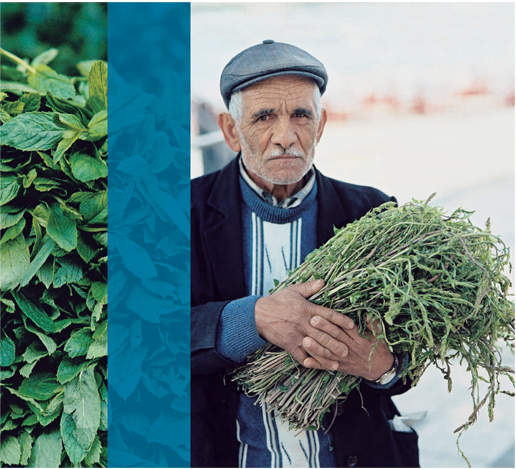
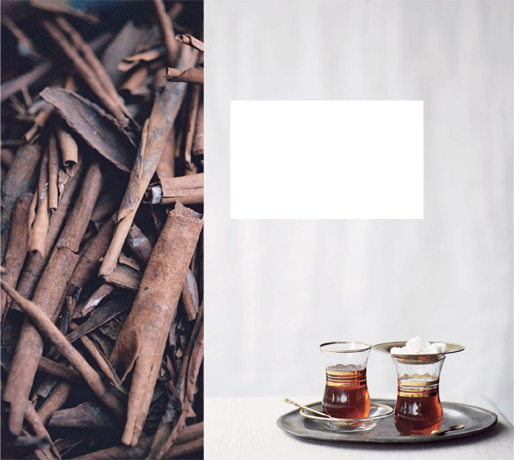
By the time we’d sipped down a much-needed digestif of spicy za’atar tea – made from wild thyme – it was close to midnight and we realized the restaurant was empty. We’d been listening to this compelling, dazzling, exhausting man for more than five hours and had only scratched the surface of his extraordinary knowledge. As we said our warm goodbyes and headed out to catch the last ferry back to Europe, Greg muttered happily, ‘I’d come back to Turkey for this food alone.’
Gypsy salad
A favourite Turkish salad using raw vegetables, which make it wonderfully crunchy. Sometimes gypsy salads are made with grated hard white cheese, but I prefer to use a tangy yoghurt dressing instead. The dried apricots aren’t traditional, but I love their soft, chewy sweetness against the crunch of the vegetables.
2 vine-ripened tomatoes, skinned and diced
1 Lebanese cucumber, peeled, seeded and diced
1 small purple onion, peeled and diced
4 dried apricots, diced
3 baby carrots, diced
1 long yellow pepper, diced
1 clove garlic, crushed
½ teaspoon sea salt
100 g thick natural yoghurt
1 tablespoon extra-virgin olive oil
juice of ½ lemon
1 red bullet chilli, seeded and finely shredded
1 teaspoon ground cumin
freshly ground white pepper
Put the tomatoes, cucumber, onion, apricots, carrots and yellow pepper into a large bowl and toss gently.
Crush the garlic with the salt. In another bowl, whisk the yoghurt with the garlic and salt and remaining ingredients to make a dressing. Pour on enough to coat the vegetables and toss gently.
SERVES 4
Toma to s alad with tarragon, aged fetta and sumac dressing
Use really tasty tomatoes for this salad: I like to use a selection of the heirloom tomatoes that are becomingly increasingly available from greengrocers’ and markets, but ripe tomatoes on the vine will do well too. You can buy barrel-aged fetta from good Mediterranean food stores. It’s much firmer than young fetta, and has a sharp, earthy flavour. If you can’t find barrel-aged fetta, substitute a hard, aged goat’s cheese.
2 shallots, peeled and sliced into wafer-thin rings
3 tablespoons shredded French tarragon
50 ml Sumac Dressing
4 heirloom or vine-ripened tomatoes, skinned and thickly sliced
sea salt
freshly ground black pepper
120 g barrel-aged fetta, crumbled
Soak the shallot rings in iced water for 10 minutes, then pat dry with kitchen paper. In a small bowl, toss the shallots with the tarragon and enough dressing just to moisten. Tumble the sliced tomato onto a serving platter and season lightly. Scatter on the shallots and fetta, then drizzle with a little more dressing and serve.
SERVES 4
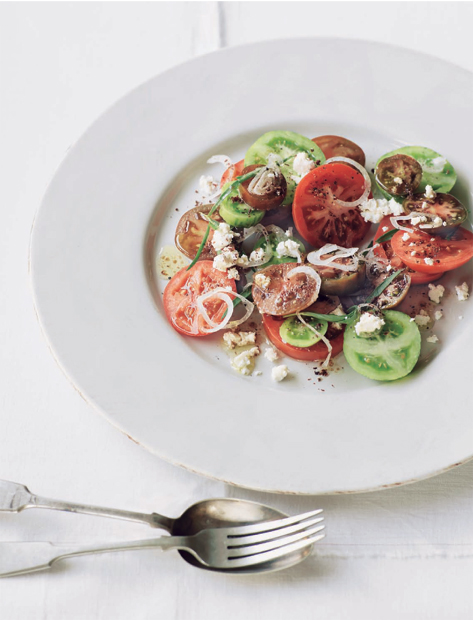
Tomato Salad with Tarragon. Aged Fetta and Sumac Dressing
Witlof and radicchio salad with Caesar dressing, pastirma and soft-boiled eggs
Pastirma, Turkey’s highly spiced and garlicky version of pastrami, is often served for breakfast with eggs, the bland richness of the yolks offsetting the meat’s strong flavour beautifully. Pastirma works brilliantly with this creamy Caesar-style dressing too; for a change, you could grill or fry it like bacon. Ask for the pastirma to be sliced wafer-thin.
4 free-range eggs
4 witlof, outer leaves removed
1 small radicchio, roughly torn
½ cup flat-leaf parsley leaves
1 large shallot, peeled and finely sliced
freshly ground black pepper
50 g pastirma, finely sliced
CAESAR DRESSING
2 free-range eggs, lightly poached
1 clove garlic, finely chopped
4 anchovy fillets
juice of 1 lemon
splash of white-wine vinegar
1 tablespoon Dijon mustard
200 ml olive oil
200 ml vegetable oil
sea salt
freshly ground black pepper
¼ cup finely grated parmesan
To make the dressing, blitz the eggs, garlic, anchovies, lemon juice, vinegar and mustard in a food processor, then gradually drizzle in the oils, a little at a time, ensuring each amount is incorporated before adding more. Season with salt and pepper and if necessary thin with a little warm water until the dressing is the consistency of pouring cream. Stir in the parmesan.
If you’ve taken the eggs straight from the refrigerator, put them into a bowl of hot tap water for 5 minutes to bring them to room temperature. Bring a saucepan of water to the boil. Carefully lower in the eggs and cook for 5½ minutes. Remove from the water and refresh briefly under cold running water.
While the eggs are cooking, cut the witlof into quarters lengthwise and arrange in a large shallow serving bowl. Scatter in the lettuce, parsley and shallot and pour on enough dressing to coat the leaves. Season with pepper. Peel the eggs and halve them carefully, then add to the bowl. Drape slices of pastirma over the salad and serve immediately.
SERVES 4
Brain salad with parsley and black olive dressing
Poached brains are a popular mezze dish in Turkey, but they often don’t look terribly appealing, as they tend to be served cold and unadorned. They have a wonderful mild, creamy flavour and texture that really comes alive with a tangy dressing. If you like, serve them with thin slices of sourdough toast.
One of the great joys of lamb’s brains is that they are blissfully easy and relatively unmessy to prepare, which may surprise some. An initial soaking dispels any lingering blood, after which the brains need only to be poached briefly. No peeling required!
4 sets of lamb’s brains
cold salted water or milk
1 lemon, cut into quarters
1 cinnamon stick
4 cloves
½ onion
1 litre water
1 quantity Parsley and Black Olive Dressing
Soak the brains in cold salted water overnight, or in milk for 2 hours.
Place the lamb’s brains in a large non-reactive saucepan with the aromatics and water. Bring to the boil, then skim and simmer for 2 minutes. Remove the pan from the heat and allow the brains to cool in the liquid. When they are cold, remove them from the pan and split each set in half. Pat dry with kitchen paper.
Slice the brains thickly, arrange on a serving plate and spoon on the dressing.
SERVES 4
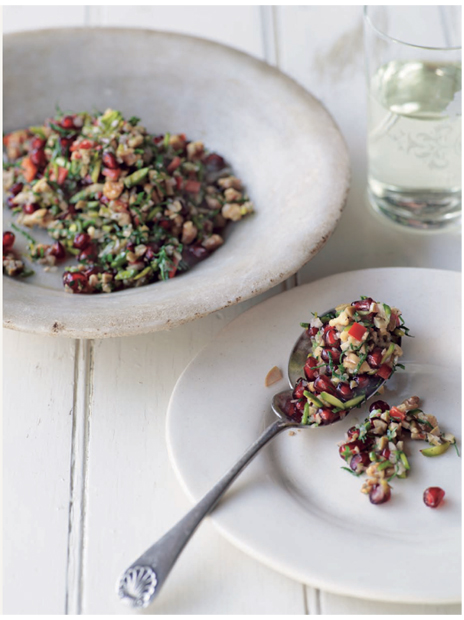
Green olive, walnut and pomegranate salad
Green olive, walnut and pomegranate salad
A stunning salad from south-east Turkey where all the ingredients grow in abundance. I love the balance of sweet, salty and chilli-hot, and the ruby-red pomegranate seeds look gorgeous against the muted khakis and greens of the other ingredients.
¾ cup walnuts
½ cup pitted green olives, washed and coarsely chopped
¼ cup unsalted shelled pistachios, coarsely chopped
½ cup pomegranate seeds
2 small shallots, peeled and finely diced
1 red bullet chilli, seeded and finely diced
1 tablespoon shredded flat-leaf parsley leaves
1 tablespoon olive oil
1 tablespoon walnut oil
splash of pomegranate molasses
juice of ½ lemon
sea salt
freshly ground black pepper
Preheat the oven to 180°C. Scatter the walnuts onto a baking tray and roast for 5–10 minutes until a deep golden brown. Tip the nuts into a tea towel and rub well to remove as much skin as possible. Chop the walnuts coarsely and toss in a sieve to remove any remaining skin and dust. Combine all the ingredients in a large bowl and toss gently. Leave to stand for 5 minutes or so before serving, to allow the flavours to meld.
SERVES 4
Grated celeriac salad
Celeriac is a popular and versatile winter vegetable that the Turks make good use of in soups, dips, braises and salads. I’ve combined it here with witlof, peppers, chilli and fetta in a tangy dressing; it makes a tongue-tingling and refreshing winter salad to serve alongside grilled chicken, lamb or a good thick steak. The salad should be eaten within 30 minutes or so of preparation for best results.
1 celeriac
1 small clove garlic
sea salt
2 long yellow peppers, shredded
1 purple witlof, shredded
1 small purple onion, finely sliced
1 long red chilli, seeded and shredded
2 tablespoons shredded flat-leaf parsley leaves
2 tablespoons shredded mint leaves
½ teaspoon dried mint
1 tablespoon champagne vinegar
2 tablespoons extra-virgin olive oil
freshly ground black pepper
80 g fetta, roughly crumbled
Peel the celeriac and trim off the ends. Cut the celeriac in half, then scoop out any soft, pulpy flesh from the centre and discard it. Grate the celeriac into a bowl of lightly acidulated water.
Crush the garlic with ½ teaspoon salt. Combine garlic with the remaining ingredients, except for the fetta, in a large bowl. Drain the celeriac and dry it thoroughly on kitchen paper, then add it to the bowl and toss everything well. Taste and adjust the seasoning, then tip onto a serving platter and top with the fetta. Serve straight away.
SERVES 4
Shepherd’s salad
This is the classic Turkish ‘garden’ salad that you find in restaurants and homes all around the country. It’s a bit like the Lebanese salad fattouche, using commonly available ingredients that many people have growing in their gardens.
1 long yellow pepper
1 long cucumber
2 long green chillies, seeded and shredded
2 vine-ripened tomatoes, skinned and cut into large dice
1 small purple onion, peeled and cut into large dice
6 radishes, sliced
1 cup flat-leaf parsley leaves
2 tablespoons chopped dill
1 baby cos lettuce, shredded
juice of ½ lemon
2 tablespoons extra-virgin olive oil
sea salt
freshly ground black pepper
Quarter the pepper lengthwise, scraping out the seeds and removing the membrane, then slice. Quarter the cucumber lengthwise, then scoop out the seeds and slice. Toss all the ingredients in a large serving bowl and taste and adjust the seasoning.
SERVES 4
Mezze
Turkish cooking is perhaps best known for the seemingly endless little mezze dishes, either offered at the start of a meal or extended to make up an entire meal lasting many happy hours. It’s a well-known and distinctive category, yet surprisingly difficult to define, as just about anything can be served as a mezze.
Although mezze dishes will vary with the season and the locale, one defining characteristic is the abundance of choice. There may be a selection of ezme (mashed vegetables mixed with garlic and yoghurt) or yoghurt dips like cacik or haydari or small dishes of gleaming olives and dolmas (stuffed vegetables). Near the sea, enticing little fish dishes of braised squid or fried whitebait, stuffed mussels or grilled sardines will be offered. A mezze nearly always includes cubes of beyaz peynir – soft white fetta cheese, sprinkled with fresh herbs and olive oil – and just about anything that might be termed a salad.
Delicious seasonal salads will be made with whatever is available – such as the ubiquitous shepherd’s salad of chopped tomatoes, cucumbers, peppers and onion. Other salads might be made with pulses, such as lentils or white beans, or with bulgur wheat softened with a simple dressing of olive oil and lemon juice. Zeytinya li (vegetables cooked in olive oil) are served cold and are very popular. Broad beans, artichokes, eggplant or zucchini are often prepared in this way, and along the Aegean you’ll find an extraordinary selection of wild greens that are gently wilted and served with fruity olive oil and a splash of lemon juice.
li (vegetables cooked in olive oil) are served cold and are very popular. Broad beans, artichokes, eggplant or zucchini are often prepared in this way, and along the Aegean you’ll find an extraordinary selection of wild greens that are gently wilted and served with fruity olive oil and a splash of lemon juice.
Another defining characteristic of the mezze table is the raki that is drunk as an accompaniment. The Turks would find it hard to imagine eating mezze without raki as the two are inextricably linked. The tradition, believed to date back many centuries, began with small tasty dishes being offered in taverns to merchants and travellers to soak up the alcohol – very similar to the Spanish tradition of tapas. Despite the conversion of the Turks to Islam, the mezze tradition survived – which either says a lot for the appeal of the raki or of the food! Today some of the best mezze can be found in meyhane restaurants.
Turkish spoon salad
One of my very favourite Turkish salads, this almost has the consistency of a gazpacho soup and definitely needs to be served with a spoon. The secret of its success is to dice the ingredients individually first, then chop them together to very fine and even dice. This salad has a wonderful balance of heat from the chillies and sweetness from the molasses. Serve it with kebabs and offer plenty of Turkish bread to mop up the juices.
The chilli paste used here is readily available from Turkish food stores.
2 very ripe vine-ripened tomatoes, skinned and finely diced
1 long red pepper, seeded and finely diced
2 long red chillies, seeded and finely diced
1 small Lebanese cucumber, peeled, seeded and finely diced
1 large shallot, peeled and finely diced
2 tablespoons finely chopped flat-leaf parsley leaves
½ teaspoon dried mint
1 heaped teaspoon hot Turkish red pepper paste
½ teaspoon pomegranate molasses
1 teaspoon red-wine vinegar
60 ml extra-virgin olive oil
sea salt
freshly ground black pepper
pomegranate seeds to garnish (optional)
Place the diced tomatoes, pepper, chillies, cucumber and shallot on a large chopping board. Use a very sharp, large knife to chop them all together. You are aiming for well-integrated, even and fine dice. Scrape into a large bowl and add the herbs, pepper paste, molasses, vinegar and 1 tablespoon of the oil, then season with salt and pepper. Stir throughly and leave for 20 minutes to macerate.
Just before serving, tip the salad into a colander and drain for a few moments to remove some of the excess liquid – you want the salad to be wet, but not swimming in liquid. Pour out onto a shallow serving platter, then drizzle on the remaining oil and scatter over the pomegranate seeds, if using. Serve straight away.
SERVES 4
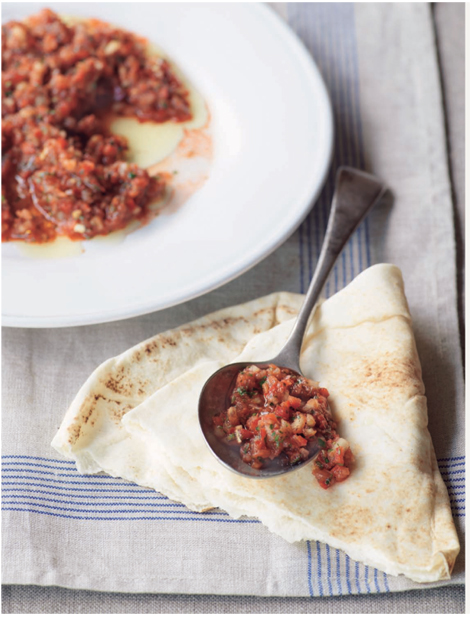
Chopped cos salad with green herbs
This salad is a great accompaniment to all sorts of grilled meats, and is especially good with kebabs.
2 baby cos lettuces, outer leaves discarded
handful of wild rocket leaves, stems removed
2 spring onions, finely chopped
2 tablespoons chopped dill
2 tablespoons chopped flat-leaf parsley leaves
1 tablespoon chopped mint leaves
1 small clove garlic
½ teaspoon sea salt
60 ml extra-virgin olive oil
juice of ½ lemon
½ teaspoon dried mint
freshly ground black pepper
Shred the lettuce leaves, then toss gently in a large bowl with the rocket, spring onions and herbs.
Crush the garlic with the salt and whisk with the remaining ingredients to make a dressing. Taste and adjust the seasoning before dressing the salad.
SERVES 4
À la Turque dressing
This full-flavoured dressing suits bitter salad leaves or warm vegetable salads. Try it, too, with fish or seafood, or over warmed beans or pulses.
120 ml water
1 tablespoon white-wine vinegar
1 teaspoon honey
1 teaspoon pomegranate molasses
2 small shallots, very finely diced
1 small clove garlic, very finely diced
1 long green chilli, seeded and finely diced
½ vine-ripened tomato, seeded and finely diced
1 teaspoon dried mint
2 tablespoons chopped dill
pinch of hot paprika
sea salt
½ teaspoon freshly ground black pepper
juice of 1 lemon
120 ml extra-virgin olive oil
In a small saucepan, combine the water and vinegar with the honey and molasses. Warm the pan gently to dissolve the honey, then add the shallots, garlic and chilli. Simmer for a minute, then pour into a large bowl and leave to cool.
Add the tomato, herbs and paprika and season with salt and pepper. Whisk in the lemon juice and oil, then taste and adjust the seasonings if necessary. Pour into a sealable jar. The dressing will keep, refrigerated, for up to a week.
MAKES 300 ml
Sumac dressing
Sumac berries have a wonderful lemony tartness and are very popular in Turkey and the Middle East. You’ll find them in Turkish or Middle Eastern food stores. This dressing is used in the tomato salad but can also be used with bitter leaves such as witlof or radicchio.
 cup sumac berries
cup sumac berries
120 ml warm water
200 ml extra-virgin olive oil
juice of ½ lemon
1 teaspoon caster sugar
drizzle of pomegranate molasses
sea salt
freshly ground black pepper
1 sprig thyme
1 clove garlic, crushed
Crush the sumac berries roughly in a mortar. Tip into a small bowl and pour on the warm water. Leave to infuse for 45 minutes, then strain through a fine cloth into a measuring jug and reserve 100 ml.
In a bowl, whisk the sumac water with the oil, lemon juice, sugar and molasses. Season with salt and pepper and add the thyme and garlic. Leave to infuse for 20–30 minutes, then strain into a sealable jar. The dressing will keep, refrigerated, for up to 3 weeks.
MAKES 300 ml
Tomato and chilli dressing
This wonderfully zesty dressing marries well with grilled seafood. It’s a particularly good match with grilled shellfish.
3 vine-ripened tomatoes, skinned, seeded and diced
2 red bullet chillies, seeded and finely diced
1 clove garlic, finely diced
2 tablespoons caster sugar
juice of 2 lemons
150 ml olive oil
100 ml walnut oil
sea salt
freshly ground white pepper
Whiz all the ingredients except for the oils, salt and pepper to a fine, smooth purée in a food processor. With the motor running, gradually add the oils until they are fully incorporated. Check the seasoning and add salt and pepper to taste. Pour into a sealable jar. The dressing will keep, refrigerated, for up to 5 days.
MAKES 450 ml
Pomegranate and tomato dressing
This dressing takes on a different feel, depending on the season. A jar of pomegranate molasses in the cupboard means I can make the dressing year-round to use with freshly shucked oysters, warm vegetable salads or brushed onto the barbecue. When pomegranates are in season, I use the fresh juice and seeds instead: follow the recipe below, substituting 60 ml freshly squeezed pomegranate juice for the molasses and increasing the quantity of oil to 275 ml.
110 ml red-wine vinegar
30 ml pomegranate molasses
250 ml extra-virgin olive oil
3 shallots, halved
1 clove garlic, halved
4 sprigs thyme
1 vine-ripened tomato, seeded and finely diced
½ teaspoon sea salt
generous grind of pepper
Whisk the vinegar and molasses in a small bowl, then stir in the oil. Add the shallots, garlic, thyme and tomato and season with salt and pepper. Cover and leave for 6 hours or overnight, so that the flavours mingle and intensify. Strain through a fine sieve into a sealable jar. The dressing will keep, refrigerated, for a couple of weeks.
MAKES 400 ml
Circassian yoghurt dressing
One of my favourite herbs, fresh coriander, is rarely used in Turkish cooking, except in Circassian dishes. I developed this gorgeous creamy dressing as a way of combining coriander with my other favourite ingredient, yoghurt. It’s tangy, aromatic and a bit spicy, and redolent of the ancient spice routes.
Serve this dressing with vegetable salads, grilled chicken or even as a dip with raw vegetables and toasted flat bread.
4 cardamom pods
1 teaspoon black peppercorns
1 teaspoon caraway seeds
2 cups coriander leaves
3 long green chillies, seeded
4 cloves garlic
¼ teaspoon sea salt
splash of water
300 g thick natural yoghurt
Crush the cardamom, peppercorns and caraway seeds with a mortar and pestle, then sift to remove the husks.
Wash and dry the coriander. Blitz the coriander, crushed spices, chillies, garlic, salt and water to a purée in a blender. Tip into a bowl and stir in the yoghurt to form a smooth, pale-green dressing. If it’s too thick, loosen with a little water.
MAKES 400 ml
Dill and lemon dressing
This dressing is often served with Creamy Fava Bean Pâté as a mezze dish. It’s also extremely good with grilled white fish or seafood, barbecued chicken or quail, and all sorts of cold salads and vegetable dishes.
160 ml extra-virgin olive oil
juice of 1 lemon
1 tablespoon champagne vinegar
80 ml water
2 teaspoons finely chopped dill
generous pinch of dried mint
sea salt
freshly ground black pepper
Whisk all the ingredients in a bowl. Taste and adjust the seasonings if necessary. Pour into a sealable jar. The dressing will keep, refrigerated, for up to a week.
MAKES 320 ml
Parsley and black olive dressing
This dressing is a little similar to an Italian salsa verde, full of strong salty flavours, but made creamy with the addition of chopped egg.
I like to serve it with grilled fish – shellfish, in particular – and it’s delicious with the creamy texture and mild flavour of poached brains.
80 ml extra-virgin olive oil
2 tablespoons apple vinegar
 cup pitted and coarsely chopped kalamata olives
cup pitted and coarsely chopped kalamata olives
1 cold hard-boiled egg, peeled and coarsely grated
1 small shallot, peeled and finely chopped
1 clove garlic, roughly crushed
 cup shredded flat-leaf parsley leaves
cup shredded flat-leaf parsley leaves
freshly ground black pepper
In a large bowl, whisk the oil and vinegar. Add the remaining ingredients, then whisk well to combine. Taste and adjust the seasonings if necessary. Use straight away.
SERVES 4